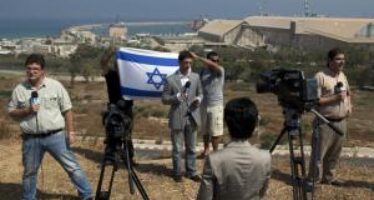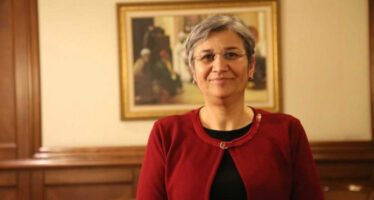The Black Carriage of the Dersim Massacre
![]()
The Black Carriage of the Dersim Massacre

Ozgur Findik tells the story of the “Black Carriage” in Dersim 38
Everyone called that train the ‘black carriage’. This was because those taken captive during the Dersim massacre had been left without food and water for days inside a carriage full of dirt and animals. They were not allowed to relieve themselves. The Armenians on the train had even been brought down to be circumcised. Ozgur Findik, who reflected the story of Dersim 38 onto the silver screen, told ANF of black carriage’s story.
Director Ozgur Findik, whose documentary titled ‘Red Pen’ explained the burning down of villages in Dersim in 1994, has now prepared a documentary, ‘Black Carriage’ on 1938 massacre. ‘Black Carriage’ that includes the narratives of soldiers, who took part in the massacre as well as the stories of Armenians exiled from Dersim, will be on screen for the first time in Bilgi University on 5th May, 74th anniversary of the massacre.
Findik, explaining that the incidents that took place in Dersim were an ethnic cleansing not a massacre, demands the General Staff archives to be opened up. We asked Findik about the ‘black carriage’ and Dersim incidents of 1930s.
How did you develop the idea of narrating the ethnic cleansing in Dersim?
I started working on the ethnic cleansing in Dersim in 1994. Firstly, I’ve made a documentary titled ‘Red Pen’. I covered the incidents starting with the burning down of villages in 1994 to the state’s approach to 1938 ethnic cleansing in Dersim by talking to the victims who witnessed the process. In fact ‘Black Carriage’ is a sequence of ‘Red Pen’. However, in contrast to other documentaries, I chose to elaborate upon the background of ethnic cleansing. I included the testimony of two soldiers who physically participated in the massacre. I have also elaborated upon the Armenians exiled from Dersim.
Where did you get the name ‘black carriage’?
Black Carriage’ was decided upon as it was the name that the people gave to the train that they were forced into. Everyone I asked whether they ‘took the train’ called it the ‘black carriage’. Hundreds of people had been forced into the train full of dirt and animals, and left there without food or water for days. They were not even allowed to relieve themselves.
Have there been exiles as the massacre was not sufficient?
The settlement law had been enacted after 1938. The whole region as well as the villages, declared to be the prohibited area, was evacuated by force. Dersim law was enacted in 1935. On May 5th, anniversary of Dersim massacre, the assembly of MPs have conducted an operation and then exiled the survivors, including women and children, to the western provinces. Families were divided and 10 individuals in every family were taken away. In fact, the massacre continued inside the ‘black carriage’, as many people were killed on the way.
How did you reach the victims and witnesses?
We have been to 25 different areas such as Balikesir, Konya, Kayseri, Manisa, Izmir, Isparta and Aydin. Then we found the exiled Armenians from Dersim, who settled in Berlin. We spoke to them. We interviewed the people, who experienced the massacre, hid under the corpses, in the caves and exiled through the ‘black carriage’.
‘THE PURPOSE OF THE ETHNIC CLEANSING WAS TURKIFICATION OF DERSIM’
How did the massacre and exile plans develop?
After the foundation of Turkish Republic, Mustafa Kemal, Fevzi Cakmak, Ismet Inonu, and Sukru Kaya team had plans for Dersim. The report prepared prior to the massacre clearly demonstrates their ideas. This was a planned movement… The state initiated a bloody movement from 1935 to 1938. It firstly confiscated all the weapons held by the tribes. Contradictions between the tribes have deepened. After the wholesale hanging of the heads of tribes, they went on to commit mass murders.
It is clear that the state had established its ideology of that time on Turkification and Sunni Islam. This is why I am one of those who believe that this massacre is not against the Kurds as in Kocgiri but instead mostly faith based. This is because the Kizilbash (Red Heads) and Armenians had been targeted, and this was an operation focused mostly on faith instead of nation. The state focused on religion instead of ethnic identity. Then it enacted a settlement law and exiled people to the West.
‘LED THEM DOWN THE CARRIAGE AND CIRCUMCISED’
There were Armenians too in the ‘black carriage’…
On the way, the soldiers were told that ‘these are Armenians, Kizilbash atheists’. When it was found out that they were Armenians, they were taken out of the carriage. In Kayseri, people who were taken out had their genitals and then circumcised. As if this was not enough, their names were changed after the circumcision and left somewhere after being told ‘you are now Muslim’. Almost all the Armenians I spoke to said ‘we avoided 1915, but could not avoid 1938’. For the Armenians of Dersim 1915 and 1938 are identical. They see themselves as part of the land of Dersim and have been longing for it all these years.
You have also spoken to the locals of areas that faced exile. How did they find the people of Dersim.
Local people had been intimidated by the state. When I asked them ‘what they thought when the people of Dersim arrived’ they said ‘we were scared as we were told that they come from mountains, have tails, they are not human and eat people and are cruel’. The narratives clearly specify that is how locals encountered Armenians.
An application has been made to the International Criminal Court for the Dersim massacre to be recognized as an ethnic cleansing. Your documentary will be important for this process.
I fully support the application of Dersim Commission to the International Criminal Court. United Nations has certain criteria in terms of the ethnic cleansing. One of these is the massacre of children and adoption by other families etc. Real ethnic cleansing took place in Dersim in 1938 after the execution of the heads of tribes. For example, female children have been given to other families and assimilated. They have been transformed into Turkish Sunnis. These certainly indicate ethnic cleansing, and a never-ending cultural-ethnic cleansing at that. All these show that after 1935 the state clearly aimed at the systematic annihilation of people, ideas, faith and culture, and Mustafa Kemal is responsible for the ethnic cleansing. However, they are all murderers. Celal Bayar is as much a murderer as Ismet Inonu.
How can this process be enlightened?
General Staff archives should be disclosed. The state should face up to history and apologize. It is not sufficient that Erdogan mentions ‘Dersim massacre’, we detect sincerity in deeds not words. Besides, my study is not completely a film or documentary, but a historical narrative. Its purpose is to make society face a reality.
THE SOLDIER WAS CRYING, COULD NOT SPEAK…
The narratives of two soldiers taken from the interviews conducted by the Lecturer Leyla Neyzi of Sabanci University are especially hair-raising. One of the soldiers did not give his name. Interspersed among his sobs, Eskeri Akyol aged 108 of 2nd Battalion 9th Unit from Diyarbakir told that:
“I’ve experienced things of which I cannot speak. These were inhuman things. My God never again allow the Ummah of Mohammed face such situations. We burned everyone alive, including women and children. We walked to Dersim from Diyarbakir throughout the seven days and nights. I’ve been assigned to Ali Strait after arrival. Houses were on fire when we reached there. Soldiers were spilling kerosene and burning down the houses with the inhabitants inside.
Our commander’s name was Ethem Atalay. It was said that he was from Elazig. Some of the people who escaped took refuge in rivers and caves. Resilient ones crossed the Munzur River. As soon as they arrived, soldiers set fire inside the caves. When we reached we saw that soldiers were placing the people who were my age now on top of one another and setting them on fire. They burned them alive. They also burned women and children. They hit the children on their heads to kill them. Many people of Dersim have been killed. Kutu Brook was reeking with corpses. They killed the people and threw them in the water. This was an unprecedented disaster. Unfortunately, there were many bad soldiers. They did not distinguish between men, women and children. They took women away to abuse. My God never again allow the Ummah of Mohammed face such situations. They were Zaza like us, and there were also Kurmanji. There were also soldiers from the villages of Dersim among us. We were the children of the same nation and fighting one another”.
Related Articles
L’ARRESTO DEI 34 GIOVANI INDIPENDENTISTI BASCHI AL MICROSCOPIO
![]()
L’analisi dell’ordinanza di arresto per i 34 giovani indipendentisti baschi Giovanni Giacopuzzi, scrittore e storico, ha analizzato per PeaceReporter tutto
Journalists at Morning Star union makes Leyla Güven honorary member
![]()
Members of the National Union of Journalists (NUJ) Morning Star Chapel made Leyla Güven a “symbolic member” following a meeting
LA SINISTRA INDIPENDENTISTA SUI FATTI DI DAMMARIE-LES-LYS
![]()
Dinnanzi ai gravi fatti avvenuti ieri nella località francese di Dammarie-Les-Lys risultati nella morte di un agente della polizia francese,




